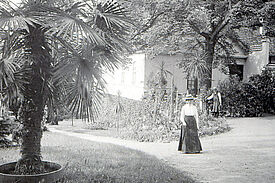
The Former Gardener’s House
The History of the Gardener’s House
The Gardener’s House, erected around 1700, is built on the ruins of the monastery’s church. Next to the church was the cemetery of the Carthusian monks. Some of these graves that date back to the Middle Ages were discovered during groundworks beside the building in 1995.
Under Grand Duke Carl August of Saxony-Weimar-Eisenach (1757 - 1828), a classicist remodelling of the gardener's house was carried out in the years 1822 - 1823 with the assistance of the chief building director, Clemens Wenzeslaus Coudray (1775 - 1845). The residence, newly designed with a ‘salon, three parlours, a bedchamber, and a kitchen’ was connected to the garden and greenhouse via a side entrance and front terrace. By the end of the 19th century, a number of extensions had been added on the northern side of the house. From the beginning of the 19th century, the gardener’s house, including the court gardener’s apartment, and the adjoining greenhouses formed one complex. After being redesigned several times, the glasshouses were removed in the 1990s and replaced with a pergola to provide shade for visitors.
In recognition of the great service of the court gardener Hermann Jäger, Grand Duchess Sophie presented twelve French pictorial wallpapers with scenes from the ancient Roman myth of Cupid and Psyche as an imposing embellishment of the salon in the gardener’s house. This is where wellknown landscapers and garden designers such as Hermann, Prince von Pückler, and Eduard Petzold gathered with Hermann Jäger and other personages to exchange ideas and experiences. Today this room can be visited as part of a guided tour.



The Pictorial Wallpaper
The production of pictorial wallpaper represents the greatest innovation of the French wallpaper industry in the 19th century. Popular at the time, these reproducible wallpapers usually depicted illusionistic landscapes emphasising a return to nature and new forms of garden design. A distinctive feature of these depictions of the ancient myth of Cupid and Psyche is their three dimensional effect.
The cycle of images from Greek mythology was first printed in 1815 by the Parisian factory of Joseph Dafour as a series of twelve pictures. The designs for the wallpaper were derived from the painters Jerry-Joseph Biondel (1781 – 1853) and Louis Lafitte (1770 – 1828).
Infrastrukturmanagement
Fachgebiet Grünflächen
Bernd Weißenborn
Heinrichstraße 11
99817 Eisenach
auf Google Maps anzeigen
Telefon: 03691 670-821
E-Mail
| Montag: | 9-12 Uhr und 13-15 Uhr |
| Dienstag: | 9-12 Uhr und 13-15 Uhr |
| Mittwoch: | 9-12 Uhr und 13-15 Uhr |
| Donnerstag: | 9-12 Uhr und 13-16 Uhr |
| Freitag: | 9-12 Uhr |
| sowie nach | Vereinbarung |


